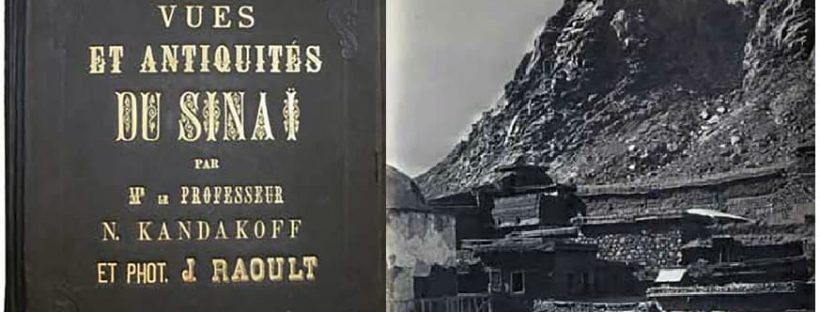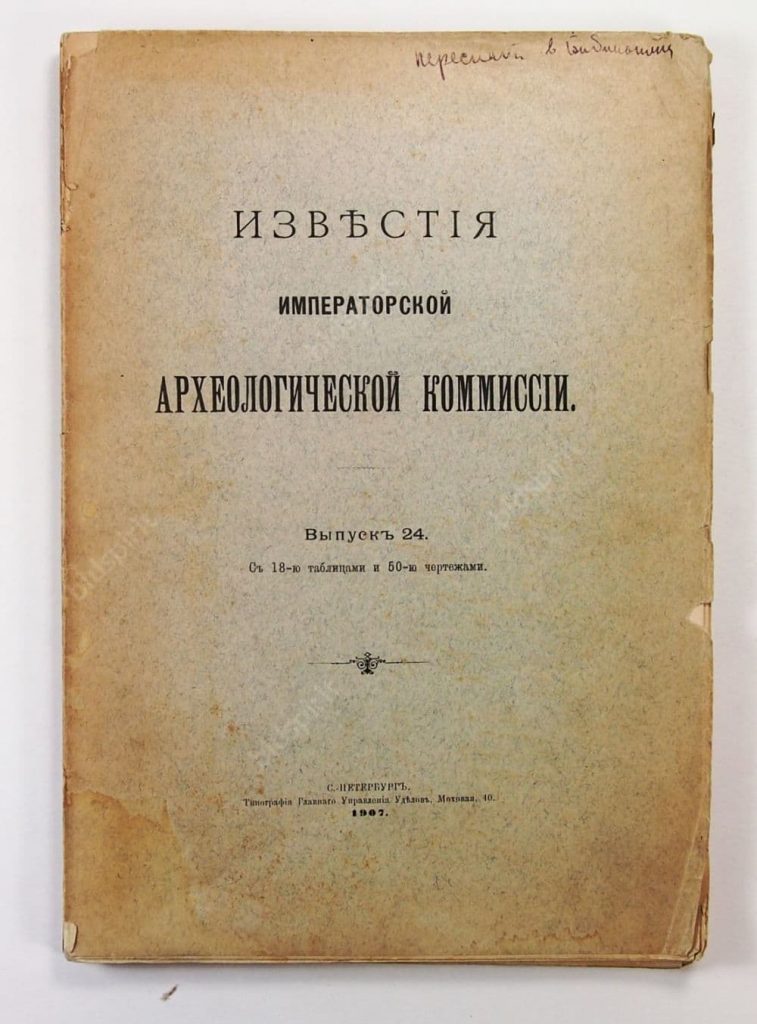Anna Adashinskaya
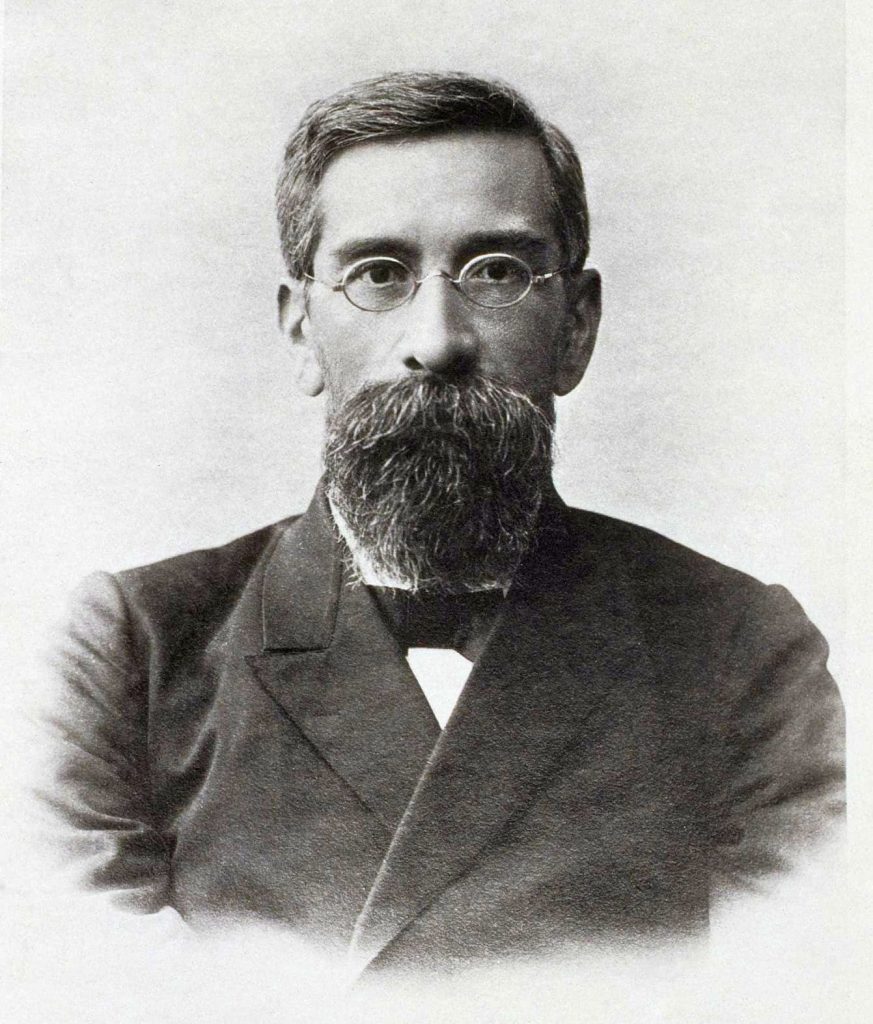
An acclaimed art historian, professor, museum curator, tireless traveler and reluctant spy: these were the social roles played by the pioneer of the iconographic method in Russia, Nikodim Pavlovich Kondakov. Every time he needed to finance a costly expedition to distant Byzantine monuments, he faced a dilemma: to spy or not to spy?
Before the middle of the nineteenth century, Russian archeological expeditions were primarily private enterprises. The founding father of Russian archeological studies, Count Aleksey Uvarov, excavated the medieval basilica on the site of ancient Chersonesos in Crimea. However, instead of preserving the monument intact, he extracted parts of the mosaics, which were later embedded in the floor of a room in the New Hermitage Palace. The main purpose of the excavations and field research, it seems, was the decoration of royal residences and the enrichment of the collection of the Hermitage as the personal museum of the Russian tsars.

In 1859, the increase in the scale of archaeological works led to the establishment of the Imperial Archaeological Commission. Control over archaeological activities in Russia was thus assigned to the Ministry of the Imperial Court, in whose department the Commission worked. The Commission issued special permits for fieldwork and sponsored research expeditions, but not very generously. In addition, it published annual illustrated reports, later called Izvestiya Archeologicheskoi Komissii (Reports of the Archaeological Commission) and became a periodical providing detailed information about excavations, collections of antiquities, and research expeditions.
Nonetheless, expeditions to foreign countries were rarely sponsored by the state. In 1881, Nikodim Pavlovich Kondakov (1844-1925) undertook a research trip to Sinai, setting, in his words, “purely archaeological goals.”[1] He wanted to compile a catalogue of the monastic antiquities and publish it as photographs. Kondakov paid for this trip himself and also financed the report’s publication, as no higher authorities were interested into sponsoring the distant journey of a young scholar working at Odessa University. During the trip, he collected about 1,500 photos taken by the photographer J.C. Raoult who accompanied him. This was an unusually large corpus of monument images, and for several decades it continued to circulate in the form of a published album which contained original photographs, (rather than typographically printed pages), alongside a written description of the trip (the number of prints in each album varied from 100 to 117).

This volume was the first photographically illustrated publication on St. Catherine’s Monastery and its rich collections. Through it, Kondakov introduced the Sinai antiquities to international scholarship and acquainted the European public with the monastery’s architecture, icon-painting, and manuscripts. Prior to this edition, researchers had only had access to drawings, which could not give an accurate idea of the medieval objects. For his work on the Sinai Album, Raoult was awarded the Order of St. Stanislav of the III degree, while Kondakov received the Lomonosov Prize in 1883. This trip made the scholar famous and contributed to his academic promotion to a position at the Hermitage Museum.
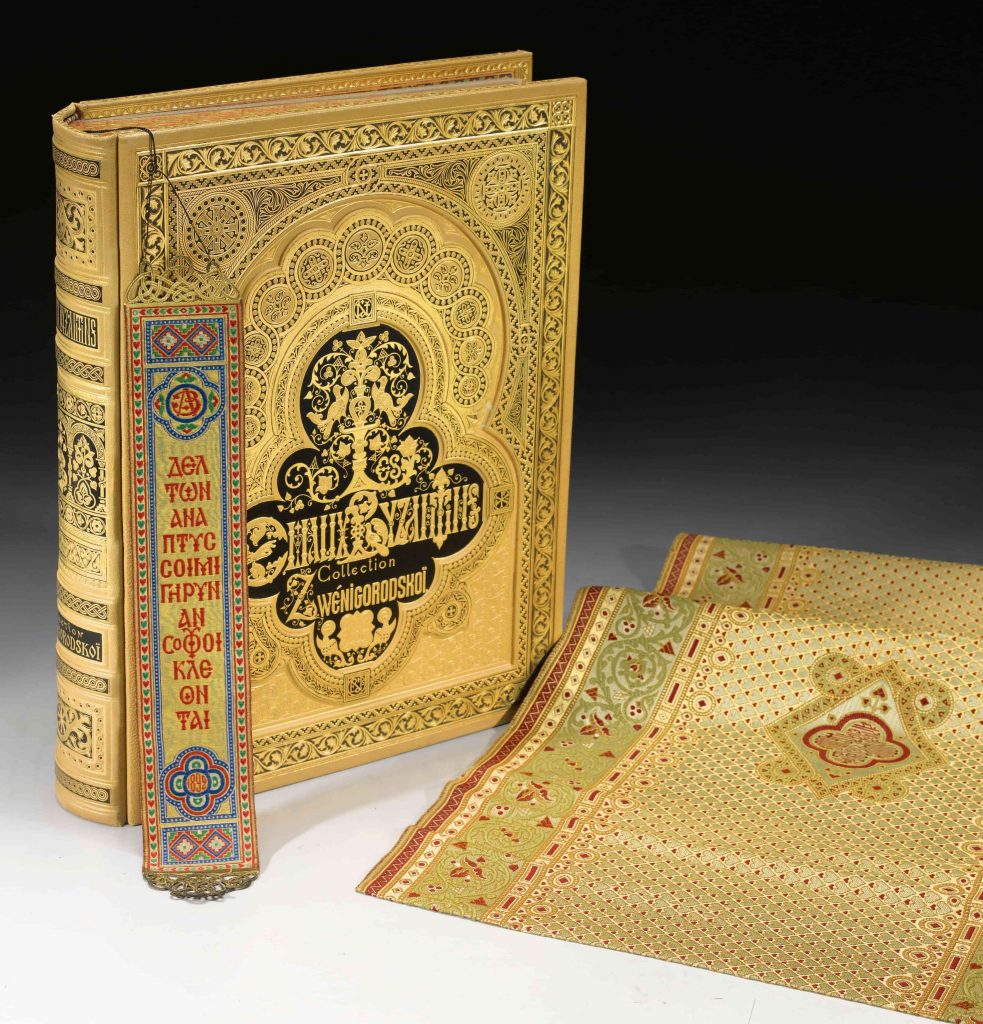
Following this expedition, Kondakov’s subsequent fieldtrips usually ended with a major research report. In this way, he introduced a great number of unknown monuments to wider scholarship. A trip to Georgia in 1889, for example, unearthed rich material for the history of Byzantine and Georgian applied arts and architecture. Yet again, this expedition was not launched on academic grounds. The reason for its undertaking was widely known to the nineteenth-century academic public,[2] namely it was due to the discovery of extraordinary large-scale thefts from the medieval monasteries of the Caucasus. Stepan Sabin-Gus,[3] an enterprising photographer with local connections, had received permission from the Georgian church authorities to replace damaged and worn-out icons and utensils with new, modern works. His indiscriminate selling-off of valuable artefacts meant that many of the most precious medieval enamels that used to adorn the icons in Georgia subsequently appeared in private collections.
The richest among these was the collection belonging to Alexander Viktorovich Zvenigorodsky (1837-1903), the Petersburg magnate and philanthropist. Before his trip to Georgia, Kondakov had already become acquainted with this extraordinary corpus of enamels and had even produced a book on the subject. Zvenigorodsky, wishing to publish his own collection of Byzantine objects, offered the project to Kondakov, who was then Senior Curator of Medieval and Renaissance Art at the Hermitage Museum. The scholar agreed, but set his own terms of collaboration. As noted in a letter from Zvenigorodsky to Kondakov[4], the Byzantinist didn’t want to become an antiquarian for a private collection gathered by a nouveau riche patron, but instead proposed to devote the volume to the history and technology of cloisonné enamel in general. Within this, Zvenigorodsky’s collection would be included as additional material.

Thanks to the collector’s extravagant demands, the published volume (1892) became one of the most expensive books in Russian history, known as the “Russian miracle” of design and printing. Zvenigorodsky hired artists to produce engravings and chromolithographs from the objects themselves, while the decorative details and binding were created using gold and brocade. The Russian version was typed in a font specially cast for this edition, based on letters from the eleventh-century Ostromir’s Gospels, the earliest dated manuscript of Kievan Rus. According to Vladimir Vasil’evich Stasov, who wrote a history of the book’s production,[5] it was never designed for sale. Almost all of the 600 copies (200 in Russian, 200 in French and 200 in German) were donated to libraries, museums and other research institutions around Europe, with only a few going to individuals. Having publicised his collection in such spectacular fashion, Zvenigorodsky then tried to sell it. In 1894, he approached the Imperial Archaeological Commission and proposed that it acquire the enamels for the Hermitage, but the Russian State unfortunately had more urgent expenditures. Eventually, the collection was bought by John Pierpont Morgan I (1837 – 1913) and passed to the Metropolitan Museum of Art in New York in 1913-1917.

The Georgian matter that really interested the Russian state was the prevention of future thefts, by recording the antiquities still held by the distant Caucasian monasteries. By the personal order of Tsar Alexander III, Kondakov was sent to the Caucasus to catalogue the objects preserved in the sacristies of the main Georgian foundations. The Tsar appointed Dmitry Zacharovich Bakradze (1826-1890), a Georgian historian and corresponding Member of the St. Petersburg Academy of Sciences, as the second member of the expedition. The Georgian scholar was responsible for reading and translating inscriptions on icons, revetments, enamels and liturgical objects, as well as for studying the general content of the ancient manuscripts described in the report. The expedition examined the sacristies of the monasteries in Gelati, Motsameti, Nikortsminda, Hopi and Martvili, together with a number of churches, including the sacristy of Zion Cathedral in Tbilisi. Kondakov’s report appeared in 1890, accompanied by multiple photographs and translations of ancient Georgian inscriptions. As Ivan Foletti has noted, a significant further purpose of this text was to represent the medieval region as a cultural periphery, both of the original Byzantine state and of the present Russian Empire.[6] In this way, the report ignored Georgia’s period of independent statehood and deprived it of its cultural diversity.
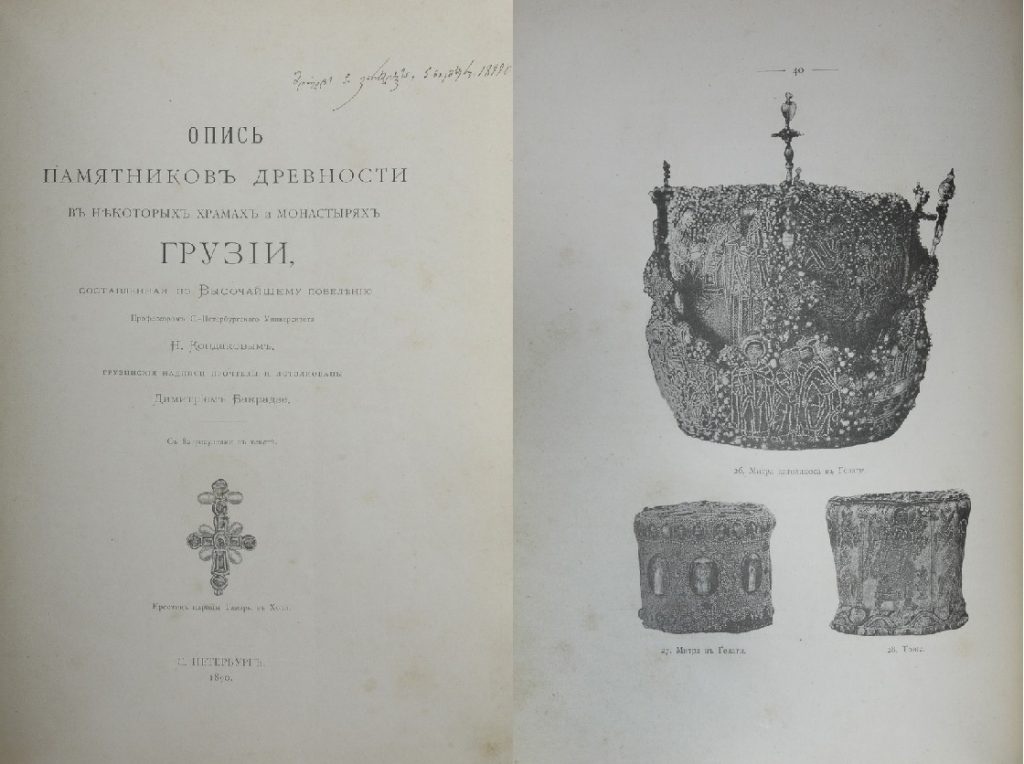
In 1891, Kondakov headed an expedition on behalf of the Imperial Orthodox Palestinian Society to study antiquities in Syria and Palestine. Among his companions were historians Yakov Ivanovich Smirnov and Akim Alexeevich Olesnitsky, a photographer from the Imperial Archaeological Commission called Ivan Fedorovich Barshchevsky, and two artists, Alexei Danilovich Kivshenko and Nikolai Andreevich Okolovich. This expedition received an unprecedented level of support from the Imperial Orthodox Palestine Society which provided 20.261 rubles in funding, twice the amount of the annual budget of the Russian Archeological Institute in Constantinople. The number of expedition participants was also unprecedented: twenty-seven people, accompanied by an impressive caravan of forty pack animals and local guides. But the reason for this generosity lay in the political interests of the Russian State.

The expedition travelled to Beirut by sea. The team followed the main roads used by merchants and hajiis and stayed overnight in small towns and villages. The route envisioned by Kondakov, however, could not be completed due to the cholera epidemic affecting southern Syria, northern Palestine and some towns in Transjordania. Where towns were closed for quarantine, the travelers were forced to stay in tents, experiencing many difficulties in the arid and rocky territory between Amman and Jericho
The Imperial Orthodox Palestinian Society was a religious and educational NGO whose aim was to establish and spread the influence of the Russian Empire in the Middle East. It included, besides missionaries and archeologists, a number of Russian agents who made connections with local religious and secular administrations, primarily targeting Arabs dissatisfied with Ottoman bureaucracy. In addition, the Society was a source of official and unofficial information for the Russian diplomatic services.
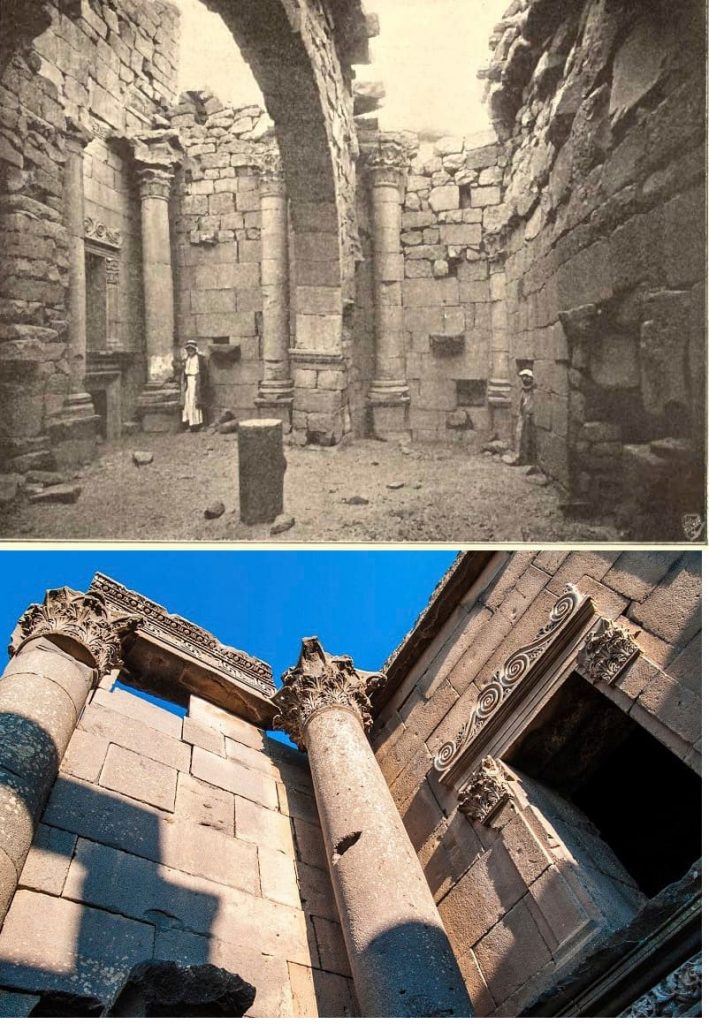
Kondakov’s expedition was part of the immediate Russian political agenda. Alongside his archeological and art historical mission, the scholar received special secret instructions issued directly by the Imperial family (Grand Duke Sergei Alexandrovich).[7] These instructions requested him to conduct secret research excavations in Jericho, “without unnecessary noise and rumors”,[8] as the Russian government did not intend to apply for an official excavation permit from the Ottoman administration. The main purpose of the excavations was to locate ancient church ruins on which the Russians could potentially ‘reconstruct’ an Orthodox church. As the Ottoman administration didn’t allow the erection of new Christian sanctuaries, this was the only way to establish a representative office of the Russian Orthodox Church in the Holy Land. Kondakov’s search was successful: in the center of Jericho, Smirnov’s sub-group found the remains of a Byzantine basilica,[9] which provided the justification the Russians needed to reconstruct a church and establish the Russian Church branch office still in existence today.
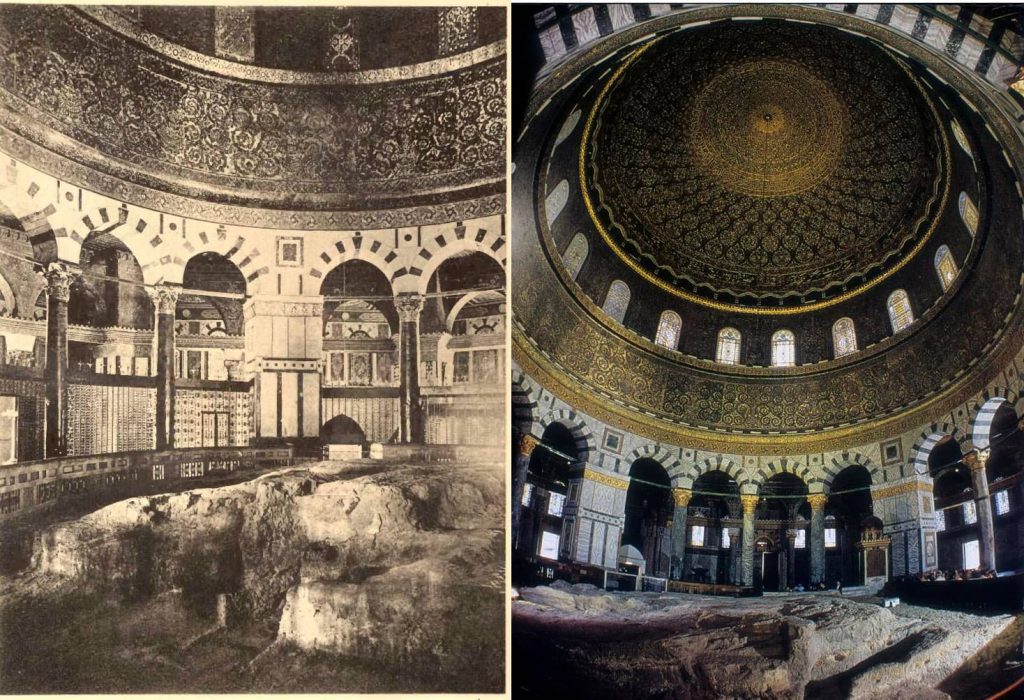
Another important assignment was to “visit local Orthodox villages along the way,”[10] especially in the Transjordan region, nowadays the state of Jordan. Kondakov planned a route which started in Beirut, passed right through Syria and Transjordania, crossed the River Jordan near Jericho and ended in Jerusalem. This convoluted itinerary allowed the collection of new demographic and economic data about this rarely visited part of the Middle East, in particular about its Christian population. According to the secret attachment to the expedition plan,[11] Kondakov was “to obtain the most accurate answers” to questions concerning the number of village residents, churches, schools, teachers, priests and the sources of their income. This collection of data on the Orthodox population in the Holy Land was not only a matter of general state interest, but also a subject of critical importance for the development of Russia’s foreign policy. By the 1890s, the Russians saw two possible ways to establish their political and religious presence in Palestine: they either could issue a loan, as requested by the local Greek clergy, or sponsor village schools and churches directly, thus bypassing the Patriarchate of Jerusalem. Both had their drawbacks: the sum of the loan was burdensome, while direct interference could endanger the existing tolerant relations with the Orthodox Church in Palestine.

Kondakov largely fulfilled the secret demands of the State (stating in his report that the Greeks requested money in order to steal it, rather than invest in churches and schooling). He also produced a book which reported his Archaeological Journey through Syria and Palestine (1904). Here, he meticulously described not only the ancient and medieval monuments of Lebanon, the Hawran region, Transjordan, Palestine, and Jerusalem, but also shared his vision of Christian archeology and offered observations on the anthropological landscape of the region. In the introductory chapter, he actively rejected the confessional approach to Palestinian archeology, considering it too narrow and exclusive. He viewed the archeology of the Holy Land as methodologically no different from that of any other region, as it “must be developed in accordance with the general methods of art historical studies, if it wishes to seek positive knowledge…”.[12] Criticizing traditional Biblical archeology, he also expressed his dissatisfaction with purely formal analysis of Palestinian art (referring to the Viennese art historian Alois Riegl), whose approach, he felt, excluded the historical circumstances surrounding the origin of a monument.[13]

Russian officials, however, were not inclined to offer significant funding when a fieldtrip could not lead to tangible political results. In 1895, Léon Gustave Schlumberger and Gabriel Millet, both members of the French Academy, proposed to the Russian Academy of Sciences the organization of a joint expedition to Mt. Athos. This endeavor should have resulted in a multi-volume publication of the artistic, diplomatic, historical, and literary monuments belonging to the monastic community, but the Russian Academy considered the project too expensive. Instead, Kondakov and several of his colleagues were ordered to organize an abridged expedition on their own. Kondakov published the results of the trip in his report The Monuments of Christian Art on Mount Athos (1902). This brief overview of eighteen monasteries and one skete, primarily addressed the icons, precious objects and manuscripts preserved in the sacristies of the ancient foundations.
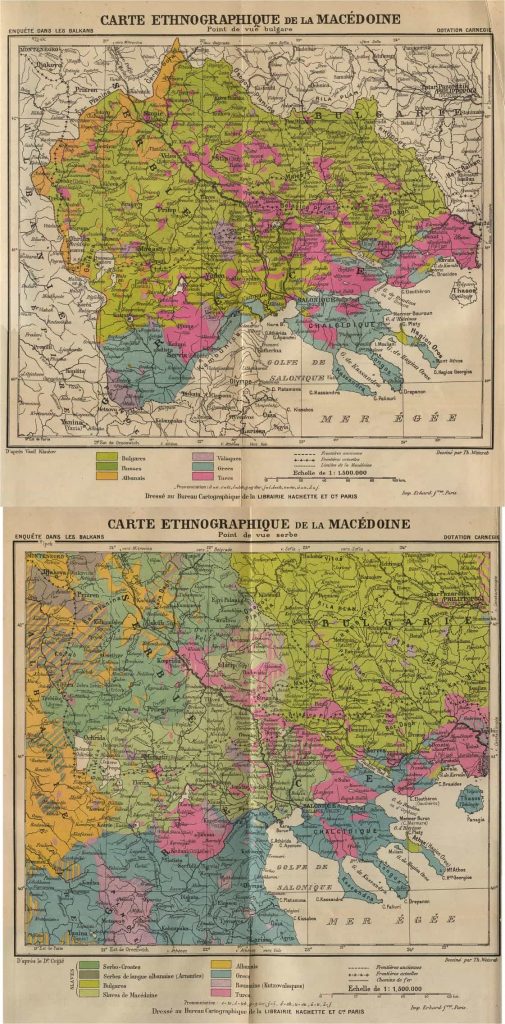
After the Berlin Congress following the 1877-78 Russo-Turkish War, international diplomacy and scholarship faced the so-called ‘Macedonian question’. The ethnically, linguistically and religiously diverse population of the region gave grounds for all emerging Balkans nations (Greece, Bulgaria, Serbia) to claim this territory as a hereditary part of their nation, but the region’s diversity also prevented the international community from finding a decisive solution to the problem. Traditionally, politicians and diplomats of the Russian Empire had supported the Bulgarian State which re-emerged largely due to the Russian victory over the Turks in 1878.
Despite the international importance of the Macedonian issue, the Russian government had only a vague idea about the state of affairs in this region. In 1900, therefore, the Imperial Academy of Sciences sent an expedition to analyze the ethnic situation on the ground and to determine whether there was historical, linguistic, or religious evidence to support the claims of the conflicting parties. As with the expedition to the Holy Land, the Romanov family personally regulated the composition and agenda of the research group, with Grand Duke Konstantin Konstantinovich directly appointing Kondakov as the group leader.
Kondakov’s choice was likely motivated by his previous success in Palestine, as well as by his expertise in art history. According to an earlier expedition report by Pavel Nikolaevich Milyukov, Bulgarian church authorities had destroyed or covered up portraits and inscriptions related to Serbian historical figures in order to erase any evidence of Serbian presence in the region.[14] Kondakov’s role, therefore, was to evaluate the condition of the historical monuments, compose a non-biased report on the scale of contemporary alterations and damage, and discuss the significance of the medieval images and inscriptions in light of current ethnic and political problems.
In his research group, Kondakov included Milyukov, as well as the philologist Petr Alexeevich Lavrov, the architectural historian Petr Petrovich Pokryshkin, and the photographer Dmitry Konstantinovich Krainev. These academics clearly recognized the political aims of the fieldtrip. As Kondakov wrote in his report, “the goal was to strive to establish such scholarly historical, archaeological and philological foundations that could be used in the future when raising a major political issue, formed both by the current position of Macedonia in the Ottoman Empire, … and by its ethnic composition in relation to the neighboring countries and nationalities of the Balkan Peninsula”.[15]
It is usually believed that the Russian art historian supported Bulgarian claims to the territory, however his views were actually more nuanced, as demonstrated in the political commentaries that he included in his Macedonian report alongside high-quality historical, iconographic and stylistic analysis of the monuments. First, he pointed to the Albanians as the source of “the constant turmoil and lack of civil order, and hence the fear that oppresses the country”. He represented them as “a wild tribe of mountaineers-shepherds… inclined to predation,”[16] and said they were used by the external powers to destabilize the Balkan Slavic states, with European and Turkish diplomacy forcing the Albanians to create unnatural political unions and to revolt. Kondakov was, however, equally unimpressed by the Balkan Slavic nations, commenting that “in Slavic countries… treacherous instincts are not only teeming in abundance everywhere, but are often the exclusive way of conducting politics.”[17] Thus, in the concluding pages of his report, Kondakov proposed his own vision of the future Balkan Peninsula. Taking into consideration the growing Albanian menace, as well as the militant, deceitful inclinations of the neighboring Austrian and Turkish Empires, one should see Slavic Serbia and Bulgaria not as competitors for territory, but rather as parts of a new political Slavic Union.[18] This vision of the Balkan future subscribed to the unfulfilled dream of Pan-Slavism ideology.
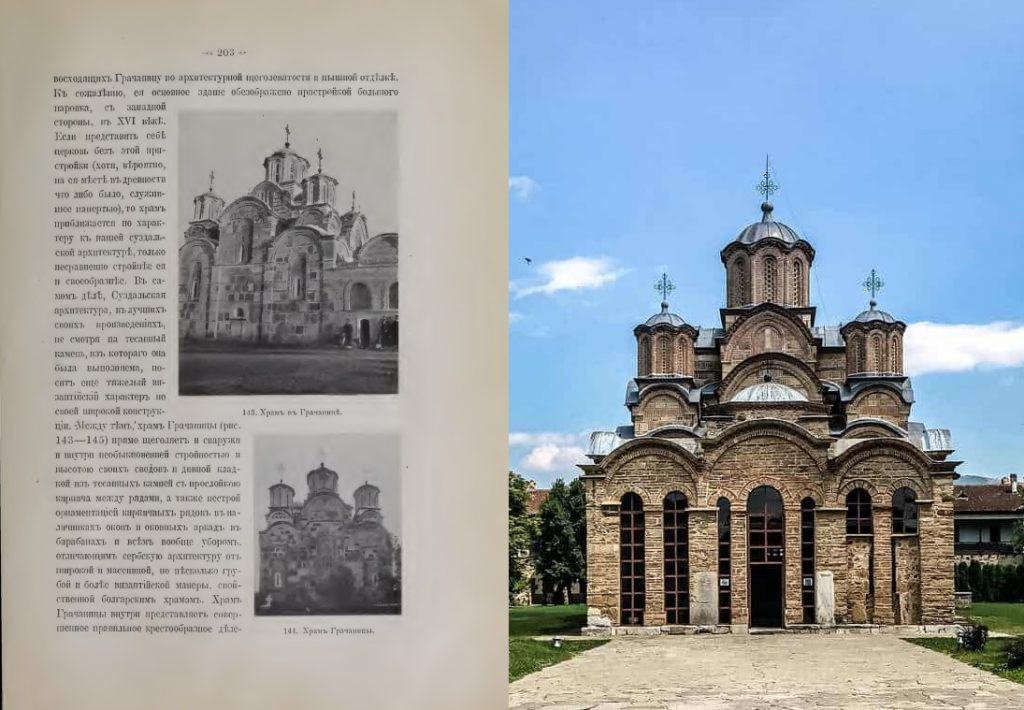
Looking at these constant struggles in Kondakov’s reports to find a balance between academic and political subject matter, one may suggest that the research expeditions, or rather their financing, was always dependent on the agenda of the Russian imperial government. From the viewpoint of the imperial establishment, an art historian was a perfect spy… in the nineteenth century as much as during the Cold War. However, a historian might have a choice: to reject politically-motivated funding and conduct an expedition at personal expense. And Kondakov did travel much on his own, but the materials he collected during these trips were never shaped in the form of ordered reports.
When, in 1916, the Russian academic milieu celebrated the fiftieth anniversary of the research activities of Nikodim Pavlovich Kondakov, his student A.M. Belov noted: “Like an ancient Argonaut, N[ikodim] P[avlovich] personally embarked on a number of journeys <… ˃, sparing neither funds, nor strength, nor his body. In Russia, it seems, there is no boondocks preserving old heritage, dear to his heart, which he would not visit to study. The Russian North with its remnants of hoary antiquity, Central Russia with its monuments dating back to the Moscovite Period, Kievan Rus with its mounds that still remember the Scythians, and finally, the Caucasus with its monuments of early Christianity – all these places attracted N[ikodim] P[avlovich] <… ˃. He knows the countries of the Balkan Peninsula very well, Turkey, especially Constantinople; he lived for a long time in Greece and Italy, explored the length and breadth of Western Europe, studying its artistic treasures, and more than once made trips to places where travelers rarely venture. So, with the same aim of bringing important material to the light of the day, N[ikodim] P[avlovich] traveled to the Sinai Peninsula, to the monasteries of Mount Athos, to the islands of the Greek archipelago, and, finally, to Syria and Palestine.”[19]
[1] Nikodim Pavlovich Kondakov, Путешествие на Синай в 1881 году. Из путевых впечатлений. Древности Синайского монастыря [The Trip to Sinai in 1881. From Travel Impressions. Antiquities of the Sinai Monastery] (Odessa: Zelensky’s Printing House, 1882): I.
[2] Fedor Ivanovich Pokrovsky, Академик Никодим Павлович Кондаков [Academician Nikodim Pavlovich Kondakov] (St. Petersburg, 1911): 4-5.
[3] The name of the photographer does not appear in Russian official sources, but it was known to some Art Historians in Georgia, see: Shalva Yasonovich Amiranashvili, История грузинского искусства [History of Georgian Art] (Moscow, 1963): 257.
[4] Archive of the Russian Academy of Sciences, St. Petersburg branch, fund No. 115, series 2, storage unit 132
[5] Vladimir Vasil’evich Stasov, История книги «Византийские эмали» А.В. Звенигородского [The History of A.V. Zvenigorodsky’s Book Byzantine Enamels] (St. Petersburg, 1898): 4.
[6] Foletti, Ivan. “The Russian view of a ‘peripheral’ region: Nikodim P. Kondakov and the Southern Caucasus,” Convivium 3/Supplementum (2016): 20-35.
[7] Archive of Foreign Policy of the Russian Empire, fond No. 337/2, series 873/1, case no. 597, fols. 7-18. The documents are partially published in: A.S. Smirnov, “Неизвестные страницы археологических путешествий Н. П. Кондакова [Unknown Pages of Archeological Journeys by N.P. Kondakov],” Rossijskij archeologicheskij ezhegodnik 1 (2011): 511-525 (here pp. 514-515).
[8] Smirnov, “Неизвестные страницы..”, 514.
[9] Nikodim Pavlovich Kondakov, Археологическое путешествие по Сирии и Палестине [Archaeological Journey to Syria and Palestine] (St. Petersburg, 1904): 137-142.
[10] Smirnov, “Неизвестные страницы..”, 514.
[11] Archive of Foreign Policy of the Russian Empire, fond No. 337/2, series 873/1, case no. 597, fol. 18
[12] Kondakov, Археологическое путешествие по Сирии, 1.
[13] Ibid., 22-25.
[14] Pavel Nikolaevich Milyukov, “Христианские древности западной Македонии” [Christian Antiquities of Western Macedonia], Izvestija Russkogo arheologicheskogo instituta v Konstantinopole 1899/4 (1899): 135.
[15] Nikodim Pavlovich Kondakov, Македония – Археологическое путешествие [Macedonia – Archaeological Expedition] (St. Petersburg, 1909): 1.
[16] Ibid., 213.
[17] Ibid., 214.
[18] Ibid., 298.
[19] Alexei Michailovich Belov, “Академик Никодим Павлович Кондаков (К пятидесятилетию его ученой деятельности)” [Academician Nikodim Pavlovich Kondakov (To the fiftieth anniversary of his academic activity], Istoricheskiy Vestnik 146 (1916): 457-458.
List of Illustrations:
- Nikodim Pavlovich Kondakov (1844-1925). Credits: https://ru.wikipedia.org/
- Chersones, Basilica discovered by Count Uvarov, engraving for Proshloe Tavridy by Yu. Kulakovsky (1906). Credits: http://www.krimoved-library.ru/
- Journal Izvestiya Archeologicheskoi Komissii, issue of 1901
- Vues et antiquités du Sinai par M. le professeur Kondakoff (Odessa, 1881) and Photo of the Library of St. Catherine’s Monastery by Jean Raoult. The extremely limited number of copies of the Album (no more than 15 were printed) meant it was already a bibliographic rarity in the 19th century. The Imperial Public Library (today The National Library of Russia in Saint Petersburg) purchased the album on September 3, 1883. This copy, containing 102 passe-partouts with 107 photograph,s is kept in the Polygraphy Department (code RNB. 15.31.1.86).
- Book cover: Histoire et monuments des émaux byzantins par N.P. Kondakov (Francfort sur Mein, 1892). Credits: Credits: https://www.sothebys.com/
- Front page of Histoire et monuments des émaux byzantins par N.P. Kondakov (Francfort sur Mein, 1892) – https://iiif.lib.harvard.edu/manifests/view/drs:47267939$1i
- Byzantine enamel with Saint George (The Metropolitan Museum, https://www.metmuseum.org/art/collection/search/464547), gift of J. Pierpont Morgan, from Zvenigorodsky’s Collection and pl. 9 from Histoire et monuments des émaux byzantins
- Book cover and Katholikos mitre from Gelati Monastery: Opis’ pamjatnikov drevnosti v nekotoryh’ hramah i monastyrjah Gruzii sostavlennaja po vysochajshemu poveleniju professorom S.-Peterburgskogo universiteta N. Kondakovym. Gruzinskie nadpisi prochteny i istolkovany Dimitriem Bakradze (Saint-Petersburg, 1890)
- Travel route from Beirut to Jerusalem of Kondakov’s expedition to Syria and Palestine in 1891
- Sanamayn Temple (Syria), illustration from Arheologicheskoe puteshestvie po Sirii i Palestine (Saint-Petersburg, 1904) and contemporary view
- The Dome of the Rock (Jerusalem), illustration from Arheologicheskoe puteshestvie po Sirii i Palestine (Saint-Petersburg, 1904) and contemporary view (Credits: https://www.flickr.com/photos/palestine_view)
- Georgian icon with medieval revetment of gold and enamel, gift of Mengrelian prince Dadiani Katsia (1770), Sacristy of the Holy Sepulchre Church, illustration from Arheologicheskoe puteshestvie po Sirii i Palestine (Saint-Petersburg, 1904)
- Kondakov and members of his expedition to Mt. Athos with the brotherhood of Vatopedi Monastery (Archive of the Russian Academy of Sciences, St. Petersburg Office)
- Ethnographic map of Macedonia from the Bulgarian viewpoint (above) and Serbian (below). Maps by the Carnegie Endowment for International Peace (1914). Credits: commons.wikimedia.org
- Gračanica Monastery (Serbia), a page from Makedonija: Arheologicheskoe puteshestvie (Saint-Petersburg, 1909) and contemporary view
—
Bibliography
- Primarily Sources
Belov, Alexei Michailovich. “Академик Никодим Павлович Кондаков (К пятидесятилетию его ученой деятельности)” [Academician Nikodim Pavlovich Kondakov (On the fiftieth anniversary of his academic activity)], Istoricheskiy Vestnik 146 (1916): 454-462.
Kondakov, Nikodim Pavlovich. Путешествие на Синай в 1881 году. Из путевых впечатлений. Древности Синайского монастыря [The Trip to Sinai in 1881. From Travel Impressions. Antiquities of the Sinai Monastery] (Odessa: Zelensky’s Printing House, 1882).
Kondakov, Nikodim Pavlovich. Опись памятников древности в некоторых храмах и монастырях Грузии составленная по Высочайшему повелению профессором С.-Петербургского университета Н. Кондаковым. Грузинские надписи прочтены и истолкованы Дмитрием Бакрадзеe [Inventory of ancient monuments in some churches and monasteries of Georgia, composed by the Highest Authority’s command by Professor N. Kondakov of St. Petersburg University. Georgian inscriptions read and interpreted by Dmitry Bakradzee] (St. Petersburg, 1890).
Kondakov, Nikodim Pavlovich. Византийские эмали. Собрание А.В. Звенигородского. История и памятники византийской эмали [Byzantine Enamels. Collection of A.V. Zvenigorodsky. History and Monuments of Byzantine Enamel Technique] (St. Petersburg- Frankfurt am Main, 1892).
Kondakov, Nikodim Pavlovich. Памятники христианского искусства на Афоне [The Monuments of Christian Art on Mount Athos] (St. Petersburg, 1902)
Kondakov, Nikodim Pavlovich. Археологическое путешествие по Сирии и Палестине [Archaeological Journey to Syria and Palestine] (St. Petersburg, 1904).
Kondakov, Nikodim Pavlovich. Македония – Археологическое путешествие [Macedonia – Archaeological Expedition] (St. Petersburg, 1909).
Milyukov, Pavel Nikolaevich. “Христианские древности западной Македонии” [Christian Antiquities of Western Macedonia], Izvestija Russkogo arheologicheskogo instituta v Konstantinopole 1899/4 (1899): 21-152.
Pokrovsky, Fedor Ivanovich. Академик Никодим Павлович Кондаков [Academician Nikodim Pavlovich Kondakov] (St. Petersburg, 1911).
Smirnov, A.S. “Неизвестные страницы археологических путешествий Н. П. Кондакова [Unknown Pages of Archeological Journeys by N.P. Kondakov],” Rossijskij archeologicheskij ezhegodnik 1 (2011): 511-525
Stasov, Vladimir Vasil’evich. История книги «Византийские эмали» А.В. Звенигородского [The History of A.V. Zvenigorodsky’s Book Byzantine Enamels] (St. Petersburg, 1898).
- Secondary Literature
Foletti, Ivan. “The Russian view of a ‘peripheral’ region: Nikodim P. Kondakov and the Southern Caucasus,” Convivium 3/Supplementum (2016): 20-35.
Foletti, Ivan. From Byzantium to Holy Russia: Nikodim Kondakov (1844–1925) and the Invention of the Icon (Rome, 2017).
Gerd, Lora. “Russian Imperial Policy in the Orthodox East and its Relation to Byzantine Studies,” in: Imagining Byzantium. Perceptions, Patterns, Problems, eds. A. Alshanskaya et al. (Mainz, 2018): 93-100.
Khroushkova, Liudmila “Kondakov,” in: Personenlexikon zur Christlichen Archäologie. Forscher und Persönlichkeiten, eds. S. Heid, M. Dennert, Vol. 1 (Rugensburg, 2012): 751-754.
Kyzlasova, Irina. “Исследовательские методы. Ф. И. Буслаева и Н. П. Кондакова,” Vestnik Moskovskogo universiteta 1978/4 (1978): 87–95.
Kyzlasova, Irina. История изучения византийского и древнерусского искусства в России [The History of Studies of Byzantine and Old Russian Art in Russia] (Moscow, 1985).
Kyzlasova, Irina, ed. Мир Кондакова. Публикации. Статьи. Каталог выставки [Kondakov’s World. Publications, Articles. Exhibition Catalogue] (Moscow, 2004).
Vzdornov, Gerold I. The History of the Discovery and Study of Russian Medieval Painting (Leiden, 2017).
 Art Historiographies in Central and Eastern Europe
Art Historiographies in Central and Eastern Europe 